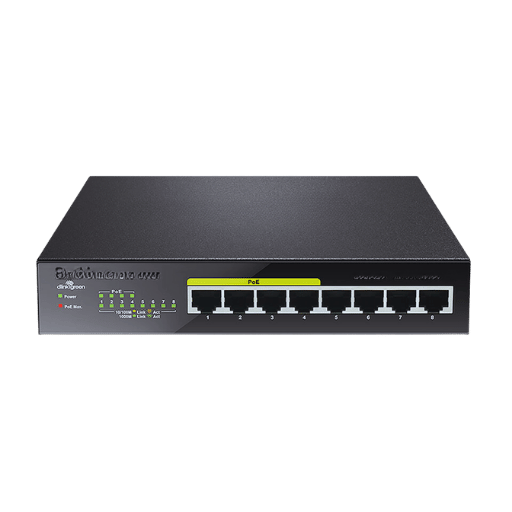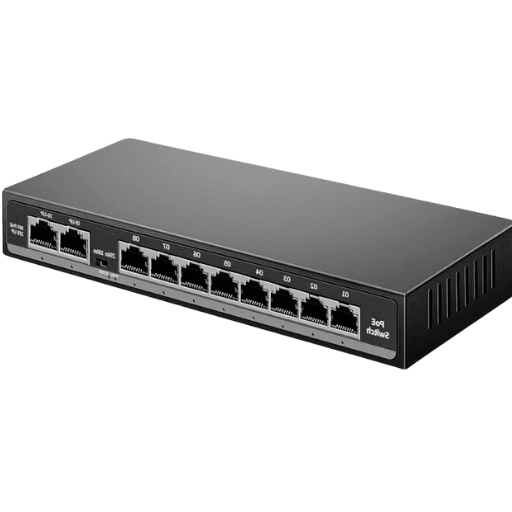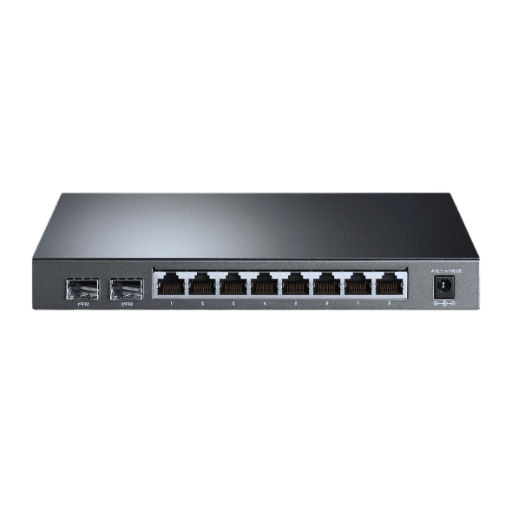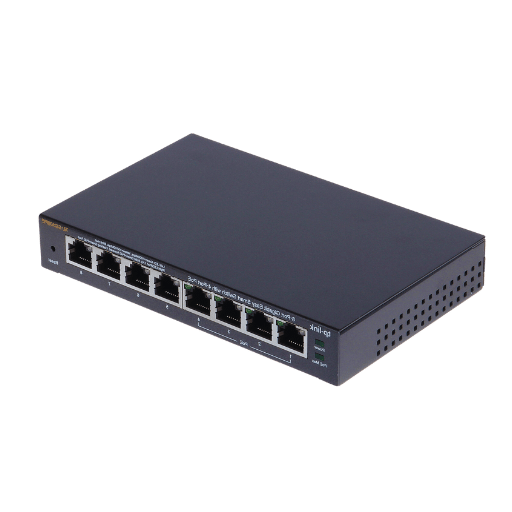In the ever-changing world of technology, it is necessary to have good network management and connectivity, be it at home or in business. This can be achieved with smart managed switches and smart switches. In this blog post, we are going to look at the details of a High-Speed 8-port Gigabit Ethernet Switch, which is an advanced device that has been created specifically for improving your network infrastructure. What sets this switch apart from others on the market is its Power over Ethernet (PoE) feature; this means that not only does it offer strong high-speed connectivity, but it also simplifies deployment by providing power and data through a single cable. Features, benefits as well as practical applications will all be discussed in order for you to gain full knowledge about what this product can do for you in terms of networking.

Ethernet cables with power over Ethernet (PoE) technology can carry electrical power as well as data. This means that IP cameras, wireless access points, and VoIP phones, among other devices, can be powered directly from the cable used for data transmission, thereby eliminating the need for separate sources of power. An 8-Port Power over Ethernet switch is a network switch with eight ports, all of which are PoE enabled, enabling multiple PoE devices to connect through one point and receive power at the same time. What this does, apart from making installations easier while reducing cable clutter, is that it also adds flexibility to network deployments.
In delivering power through Ethernet cables, these ports inject electric energy onto them by utilizing pairs of wires which are not used according to standard Ethernet cabling or using all four pairs when dealing with cable POE+ and higher standards. Voltage-regulation circuits that guarantee stable safe delivery of electricity through such means transmit the power from switch to powered device (PD). With regard to IEEE 802.3af or 802.3at standards on which they base their operation rules;PoE switches negotiate so as establish right amount of wattage required by PD.This ensures efficient distribution of energy while avoiding overloads that might occur were there no compatibility measures put in place, hence making negotiations very important, especially for smart-managed networks, which require more intricate control systems.
There are several advantages brought about by using an eight port PSE switch including simplified networking since it reduces the number of separate power cords needed, thus reducing cable cluttering around systems; Additionally it allows for system scalability whereby new poe enabled devices can easily be added without any additional infrastructure being required mainly those consuming up-to sixty watts . Another benefit is that centralizing power management enhances the reliability of networks as well as simplifies their maintenance procedures. Also, such a device comes with cost-saving benefits because individual power supplies are not needed, which saves on installation time, too . Moreover, advanced network features like VLANs and QoS, among others, can be supported by this switch so as to improve the performance levels of networks while ensuring that data packets are delivered robustly along with their corresponding energy requirements.

Gigabit Ethernet is essential for contemporary networks as it can transfer data at very high speeds that can reach up to 1 Gbps. This enables fast and efficient communication of information needed for such bandwidth-intensive applications as video conferencing, streaming media, or transferring large files. It also lowers latency while improving overall performance within a network, which makes it suitable for use in modern high-traffic areas. Moreover, gigabit ethernet offers future-proofing capabilities by accommodating increased data demand brought about by advancing technologies.
An eight-port gigabit power switch without fans comes with numerous advantages. Firstly, this type increases reliability since there are no moving parts that may fail mechanically over time. Secondly, fanless devices operate silently and hence can be used in environments where noise is not tolerated, like offices or meeting rooms. In addition to this, they save energy by consuming less power required for cooling fans which are absent anyway. Also, the lack of fans prevents dust from entering inside, thus reducing maintenance needs while extending the lifespan of the equipment.
Managed PoE switches have advanced features for configuration monitoring and security that are necessary when dealing with complex networks that need customization and control. They allow system administrators to optimize performance through setting up VLANs, among other things, besides managing traffic properly within the network environment. On the other hand, unmanaged power switches are easier to deploy because they do not require any initial setup before being used; therefore, they are best suited for small-scale networks or situations where simplicity is a priority. Though basic connectivity can still be achieved without user configuration using an unmanaged switch but managed ones offer more flexibility and control, especially in larger dynamic network setups that involve gigabit smart switches as well.

Remove the Switch from Its Box:
Choose Where to Install It:
Fix the Switch on:
Setting Up (For Managed Switches) Configuration
Check Whether Connections Have Been Established:
Perform Routine Maintenance:
Issue: The four PoE ethernet ports do not supply power to connected devices.
Resolution: It may be helpful to upgrade to a gigabit smart switch for better network performance. Also, make sure that the PoE switch is turned on and verify that the devices support PoE. Check whether the Ethernet cable is connected correctly and if so, see whether any of the port LED indicators light up or not.
Problem: I cannot access the management interface.
Solution: Make sure your computer is on the same subnet as this smart switch by confirming its IP address. Check connectivity; enter correct IP into browser.
Problem: Data transmission rates are slow.
Solution: Ensure cable quality and length are optimal; consider checking for network traffic congestion or adjusting QoS settings if necessary.
Problem: My devices keep disconnecting from one another frequently.
Solution: Look over your cables for any signs of damage while also ensuring they are plugged securely into each corresponding PoE ethernet port. If problems continue after updating firmware on switch, reset it back to default settings.
Problem: Default credentials do not let me log in.
Solution: Please refer to manual and double-check credentials you are using. Try resetting switch back to factory defaults if necessary.

TP-Link switches with eight ports that support Power over Ethernet (PoE) are famous for their reliability and cost-effectiveness. These switches are made to be strong enough for small to medium-sized networks. They have many features, like having a power supply on every port so you don’t need an adapter for each device. TP-Link has an easy-to-use management interface that makes setting up and managing networks simple, but it also includes quality-of-service settings that prioritize certain types of data traffic over others when it matters most. It also has great customer service; firmware updates are often released to patch up security holes or add new functionality where necessary – everything you’d expect from any fantastic company! In summary, then? TP-Link offers good value for money because they manage well without being expensive.
When talking about performance, one cannot forget Netgear’s 8-port PoE switches with advanced features. These devices can handle even the most demanding network environments as they were designed specifically for them – powerful throughputs combined with full PoE support across all ports guarantee this fact alone. The key point here is versatility, though; depending on what your needs may be, these could either function just fine in a small business or become essential pieces of equipment within larger corporations due to their VLAN capabilities alongside QoS traffic prioritization, among other things which greatly improve manageability overall… You’ll never have trouble getting set up either thanks not only intuitive web interfaces but also detailed documentation too – all bases are covered here!. All firmware is updated regularly so customers can benefit from better security and performance upgrades if needed at any time, day or night while maintaining a high level of satisfaction with after-sales services provided by such a reputable brand name itself. Ultimately, people who want fast networks love using net gear.
Tech enthusiasts will tell you that Ubiquiti’s 8-port PoE switches are the best because of their advanced features and user-friendly interface. These switches provide a wide range of management capabilities, including detailed analytics and remote access through seamless integration with UniFi Controller software from Ubiquiti Networks Inc., a recognized leader in wireless networking technology for service providers and enterprises around the world. They also support VLANs, link aggregation, and QoS – all these things necessary for optimal performance within any network environment where there’s a need to prioritize traffic based on the application or service being used at a specific time. Also, they’re built tough, which means they’re less likely to break down (the hardware is more reliable), while regular firmware updates help protect against security vulnerabilities – that’s why many sysadmins swear by them… There is no way around it, though: If you want networking equipment that can be controlled in every conceivable manner, then this is what you’re going to have to buy!

The term Power over Ethernet budget refers to the overall amount of power that can be provided by a Power over Ethernet (PoE) switch to all connected devices such as IP cameras, wireless access points, and VoIP phones. The budget is important since it determines how many devices can be simultaneously powered by this switch type and what kind they are. For example, if there’s a 120W PoE budget, then multiple high-power security cameras, each requiring up to 30W, could be driven from it easily. Correct computation and comprehension of the power over ethernet budget are necessary for efficient functioning of your network without overwhelming or underpowering connected devices which may result in failure of networks and reduced performance.
The number of Small Form-factor Pluggable (SFP) ports you need depends on your specific network requirements and future scalability plans. These ports are used for fiber optic connections that enable long-distance, high-speed data transmission.For small-medium sized networks, usually one or two SFP ports act as backbone connections between switches, but larger networks with rapid growth rates may require additional ones to ensure enough bandwidth is available while keeping flexibility in mind regarding where they should connect. Consider current/future data transfer needs along with physical layout when deciding how many SFP ports are needed.
Unmanaged PoE switches work well for simple networks that lack complexity in terms of configuration needs or have few devices that only require basic plug-and-play functionality on the part of administrators. However managed power over ethernet switches would be better suited towards bigger networks or environments where more advanced management features like monitoring/control options are necessary. Evaluate your network complexity & specific requirements so as to know what type of switch would best suit you.

A: The features are eight gigabit ports, Power over Ethernet (PoE) technology, two uplink ports, IEEE 802.3at compliance, a total power budget of 120W for PoE, and plug-and-play capability. It also supports fast ethernet and has a rugged metal housing that is suitable for small to mid-sized network environments needing up to 60w power per device.
A: There are eight PoE ports on this switch which allows power and data to be transmitted simultaneously over them to IP cameras, VoIP phones etc.
A: Each port provides a maximum of 30W for PoE, while all eight ports contribute equally towards an overall budget of 120 watts in an 8-port poe switch.
A: This particular model is unmanaged however it operates at gigabit speed so does not offer advanced traffic management functions found in some managed switches but is easier to set up and use.
A: With each port supporting up to gigabits-per-second rate (1000Mbps), it ensures high-speed data transfer between devices connected through different segments within network infrastructure thereby guaranteeing reliable performance across whole network like office buildings or large homes.
Q: Can this switch be used under harsh environmental conditions?
A: Yes! The sturdy metal case enables the device work within wide temperature range making it ideal for industrial settings where other equipment may fail due to heat or extreme cold temperatures.
A: These two ports can also have combo SFP ports, which provide flexible connectivity options for uplinking to servers, routers, or other switches, thus enabling more efficient network expansion with enhanced bandwidth capacity.
A: Yes! It complies with IEEE 802.3at/af standards on Poe, therefore ensuring that various devices will work together as expected within different network setups, including smart managed networks or even connecting them directly into a smart switch alongside other devices like printers, etc.
A: Through these eight ports, it is possible to conveniently connect and power such devices as IP cameras, VoIP phones, and wireless access points, among others that support Power over Ethernet technology.
A: The PoE switch contains an intuitive design. All users have to do is plug in their devices into the PoE ports and uplink ports. This will let them enjoy both power and network connectivity without any difficult configuration needed as the switch itself does everything automatically after that.